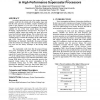496 search results - page 53 / 100 » Using the Temporal Logic RDL for Design Specifications |
IPL
2008
14 years 9 months ago
2008
Undefined terms involving the application of partial functions and operators are common in program specifications and in discharging proof obligations that arise in design. One wa...
101
click to vote
RSP
1998
IEEE
15 years 2 months ago
1998
IEEE
The complexity of distributed systems is a problem when designers want to evaluate their safety and liveness. Often, they are built by integration of existing components with newl...
CF
2005
ACM
14 years 11 months ago
2005
ACM
In modern superscalar processors, the complex instruction scheduler could form the critical path of the pipeline stages and limit the clock cycle time. In addition, complex schedu...
110
click to vote
CSL
2006
Springer
15 years 1 months ago
2006
Springer
Separation Logic is a sub-structural logic that supports local reasoning for imperative programs. It is designed to elegantly describe sharing and aliasing properties of heap struc...
115
click to vote
DKE
2008
14 years 9 months ago
2008
Logic is currently the target of the majority of the upcoming efforts towards the realization of the Semantic Web vision, namely making the content of the Web accessible not only t...

